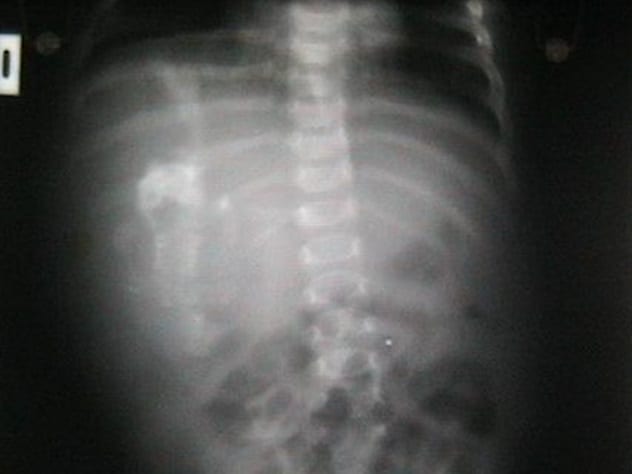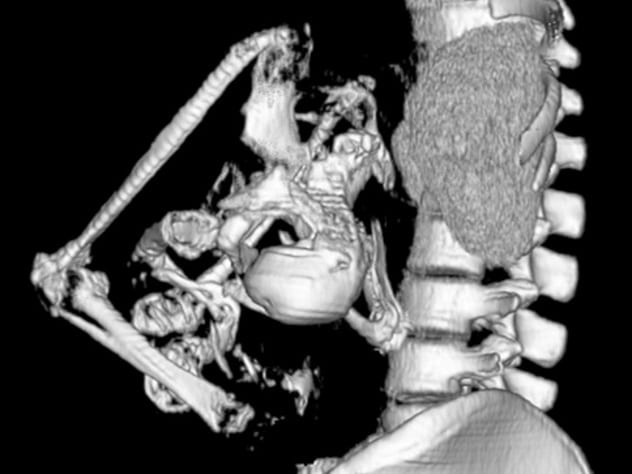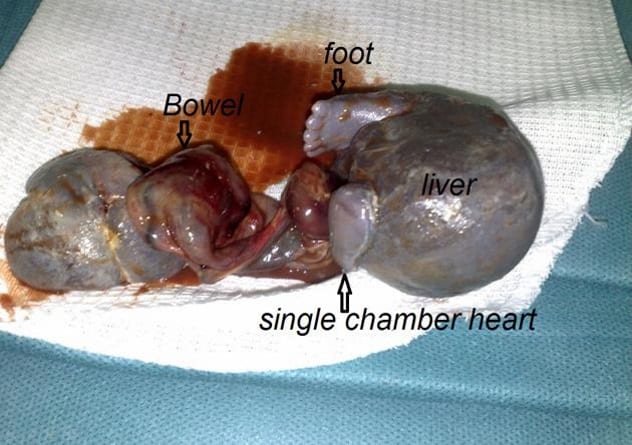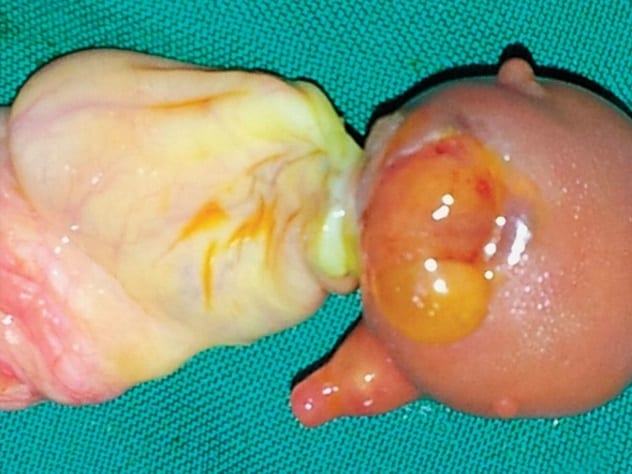 Weird Stuff
Weird Stuff  Weird Stuff
Weird Stuff  Animals
Animals 10 Inspiring Tales of Horses Being Human
 Mysteries
Mysteries Top 10 Haunting Facts About the Ghost Ship MV Alta
 History
History 10 Surprising Stories About the Texas Rangers
 Humans
Humans 10 Philosophers Who Were Driven Mad by Their Own Theories
 Miscellaneous
Miscellaneous 10 Video-Game-Worthy Weapons and Armors from History
 Weird Stuff
Weird Stuff 10 Psychics Who Accurately Predicted Wartime Events
 The Arts
The Arts 10 Pieces of Art Inspired by a Broken Heart
 Health
Health 10 Science Fiction-Sounding New Medical Treatments
 History
History 10 Surprising Facts About the Father of Submarine Warfare
 Weird Stuff
Weird Stuff 10 Times Real Laws Were Based on Bizarre Hypotheticals
 Animals
Animals 10 Inspiring Tales of Horses Being Human
 Mysteries
Mysteries Top 10 Haunting Facts About the Ghost Ship MV Alta
Who's Behind Listverse?

Jamie Frater
Head Editor
Jamie founded Listverse due to an insatiable desire to share fascinating, obscure, and bizarre facts. He has been a guest speaker on numerous national radio and television stations and is a five time published author.
More About Us History
History 10 Surprising Stories About the Texas Rangers
 Humans
Humans 10 Philosophers Who Were Driven Mad by Their Own Theories
 Miscellaneous
Miscellaneous 10 Video-Game-Worthy Weapons and Armors from History
 Weird Stuff
Weird Stuff 10 Psychics Who Accurately Predicted Wartime Events
 The Arts
The Arts 10 Pieces of Art Inspired by a Broken Heart
 Health
Health 10 Science Fiction-Sounding New Medical Treatments
 History
History 10 Surprising Facts About the Father of Submarine Warfare
10 Twisted Facts About Fetus In Fetu From Science
Throughout the entire history of life, birth abnormalities have always occurred. Occasionally, these defects border on the strange, bizarre, unusual, and grotesque. Such is the case with fetus in fetu, a rare condition wherein one twin in a set of twins is found in the body of the other.[1]
Some have referred to this condition as babies being born “impregnated.” While this is definitely not the proper term, the concept isn’t too far off, as when fetus in fetu occurs, one would-be individual is wholly inside the developing fetus of another. Sometimes, this condition is not noticed, and a single baby is born with another individual completely engulfed within them. Here are ten twisted facts about fetus in fetu, the rare birth condition in which one individual is born with another fused entirely inside them.
10 Parasitic

Fetuses in fetu are technically parasitic twins, as the absorbed twin becomes a parasite to the the other, which serves as the host. That’s what separates fetuses in fetu, as well as individuals born after such a merge is complete, from regular sets of conjoined twins, as one lives entirely from within the other.[2] The degree to which the second individual “lives” is definitely up for speculation and debate, but so long as the cells are alive, at least to some degree, that individual lives on, albeit in an extremely rudimentary form.
This is the only case where a human can be the parasite of another human, by definition, aside from (possibly) human babies in utero, which is up for debate. The debate centers around the idea that parasites generally take from their host only, reducing fitness. In many ways, however, unborn children increase the fitness of the mother.
9 Benignity

While technically parasitic, the individual absorbed into the other generally isn’t actually a detriment to the host, besides the fact that there are pieces of one individual fused into another.[3] Sometimes it’s a spine; sometimes it’s limbs. But generally, these would-be individuals don’t actually harm the people who carry them around, sometimes for decades, if the mass of cells or body parts is not caught by doctors. Compared to the many, many masses that doctors may find in an infant or even a grown individual, fetus in fetu, while frightening, is relatively harmless.
8 The Abdomen

Most of the time, when a case of fetus in fetu occurs, the parasitic individual is absorbed into the abdomen of the host individual, in the retroperitoneal cavity.[4] Even though this is the most common place that a fetus is absorbed into another, it can be overlooked in the abdomen when doctors screen the health of a fetus or newborn child, which can lead to some rather bizarre and unusual results for some individuals later in life. Naturally, doctors should check the stomach or belly for any growths, including a fetus in fetu case, when a newborn baby is delivered.
7 Other Areas

Sometimes, fetuses are lodged into the host individual in other places besides the abdomen, but that’s even rarer than the condition in the first place. In some instances, people are born with what was once a fetus in their cranial cavity—yes, people are actually born with the mass of cells that would have been their twin inside their heads.[5]
Other areas include the mediastinum (the area that contains the heart, esophagus, and other structures) and the scrotum, of all places. Some people have been born with parts of another fused into the scrotum. As unpleasant as that sounds, compared to other growths the body can have, it’s extremely benign, as mentioned.
6 Male Predominance

Fetus in fetu births are an extremely rare event in general, but they are even rarer among women than men. There is a two-to-one male predominance in the likelihood of someone being born with another person fused inside them.
In some cases, when someone is born with a fetus in fetu case in the abdomen or scrotum, it can cause problems and developmental issues with the testes in the host individual. One patient was born with swelling in the scrotum, which then indicated that a fetus was present inside. A complete excision was made on the infant, and he was able to live an ordinary, healthy life.[6]
5 Extreme Rarity

Just how rare are fetus in fetu cases? Extremely. For reference, monozygotic twins, or “identical twins,” occur in approximately one out of every 333 births. The extremely rare condition of conjoined twins occurs once in every 50,000 to 100,000 births. Fetus in fetu cases happen once out of every 500,000 births, and there have been fewer than 100 known observed cases worldwide, so it’s unlikely that it will happen to your child or that you might be carrying another individual inside you somewhere.[7]
4 What’s Inside

So, what actually is inside an individual living with their would-be sibling in their body? Various things have been found in the extremely rare, few cases of fetuses absorbed into living individuals. Most often, vertebrae are found, but sometimes whole limbs are, too, arms and legs inside a living being.[8] Sometimes even a fetal head, hair, or a set of teeth are found inside a person. Male genitalia have been discovered floating around inside a person’s body.
It’s a good thing that medical science can find these anomalies and have them removed, considering how terrifying it must be to have portions of another person in random areas of the body. Sometimes, the mass is a ball of bones, hair, teeth, and other oddities, curiously fixed into a sphere inside the person as if the fetus is still in the womb.
3 Detection

So how do they detect fetuses in fetu? Most cases are actually diagnosed in the womb before the baby is even born, often through prenatal ultrasounds. Radiography using X-rays and related devices are also good ways to detect fetuses in fetu, and often, a combination of technologies are employed to figure out exactly what a mass is on an unborn child or infant.
Sometimes, the baby is actually born with the fetus inside still undetected. The parasitic twin is noticed as swelling presents in whichever part of the body is affected, at which point the mass is inspected. Most cases present just after birth, and 89 percent of fetus in fetu instances are discovered before the host baby turns 18 months old.[9]
2 Adulthood

Sometimes, however, fetuses in fetu are not caught by the doctors during prenatal screening, nor when the host child is born carrying the parasitic twin. Sometimes, a person grows up and goes through life not knowing that their would-have-been twin brother or sister is being toted around with them, lurking somewhere inside their body, a horrifying thought for those rare people who end up like this. In one such patient, it wasn’t until she had reached 30 years old that a head and vertebral column were discovered floating around in her abdomen.[10] Upon removal, teeth, hair, small limbs, and an umbilical cord were also found to be present.
Often, adult patients simply mistake the other fetus for swelling, or doctors mistake it for a tumor. In another patient, a parasitic twin thought to be a tumor was linked to the host twin’s blood supply and was stifling his ability to both breathe and be comfortable. Upon removal, the host twin felt much better, and all symptoms disappeared. While cases like these do happen, they are the most extraordinarily rare of all. It is believed that there have been fewer than 15 cases of fetus in fetu discovered in living adults.
1 Surgery

Fortunately, for those born with twins living inside them, especially for newborn babies who won’t remember their procedures or for the adults who gain a newfound comfort after experiencing years of discomfort due to having a mass somewhere inside, surgery works when it comes to the removal of a fetus inside of a living person.[11] After the preoperative diagnosis using radiological scans, the remnants of the parasitic twin can be removed from the host, usually without complications or problems. Surgery is the only known solution, as usually, the fetus fuses with the host well before any sort of medical intervention that we have today could possibly take place.
For all of its terrifying nature, the awful thought of possibly walking around carrying a lump of flesh that was supposed to be another human being, a sibling, the likelihood of a successful operation is quite high, especially when compared to that of conjoined twins, which have a much more dismal outlook, depending on where they are conjoined. Fetus in fetu is quite the odd, unusual, and rare condition, but for all of its psychological strangeness and the twisted images it conjures up in our minds (and medical journals), at the end of the day, it’s quite harmless.
I like to write about dark, twisted stuff, horror, true crime, and philosophy.
Read more about bizarre fetal conditions on Top 10 Bizarre Birth Defects and 10 Horrifying Things That Can Happen During Pregnancy.








